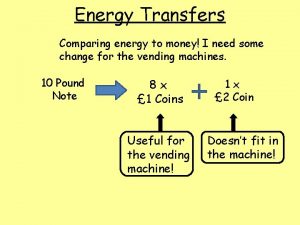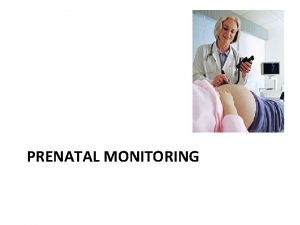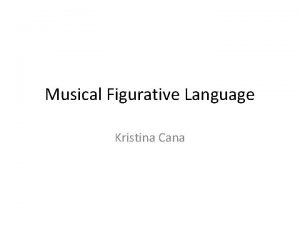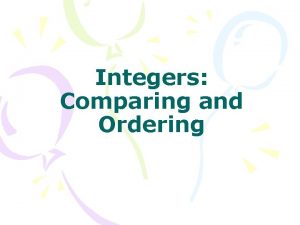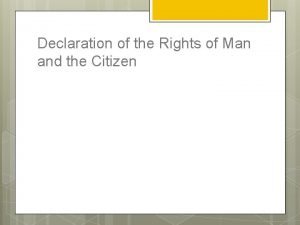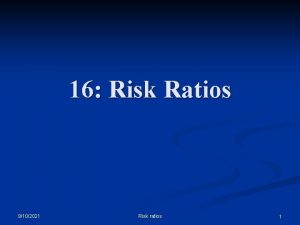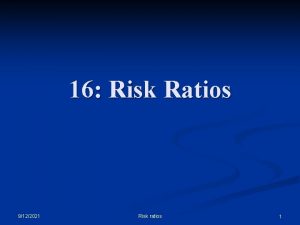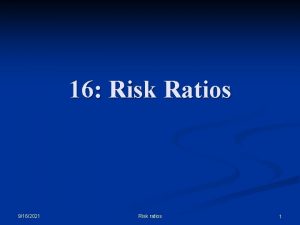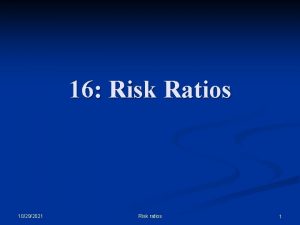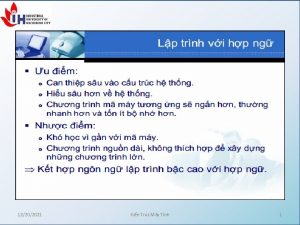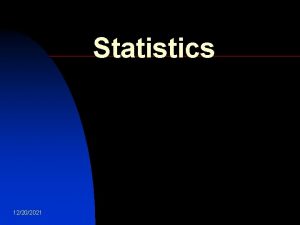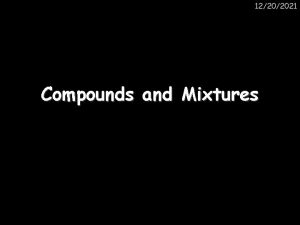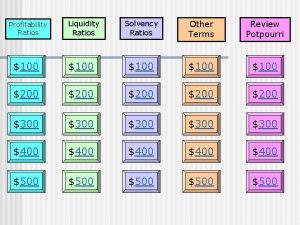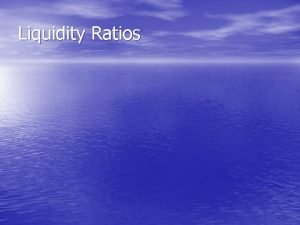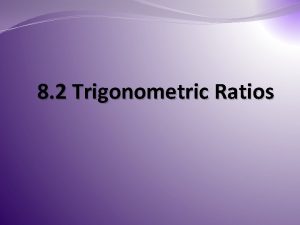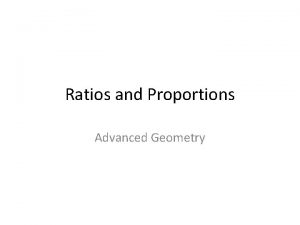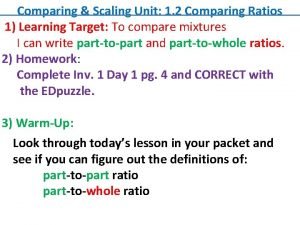16 Risk Ratios 12202021 Risk ratios 1 Comparing

















- Slides: 17

16: Risk Ratios 12/20/2021 Risk ratios 1

Comparing proportions as a ratio n n Incidence proportion (risk) = proportion experiencing an event over time Prevalence = proportions with a condition at a time Relative risk = the ratio of two risks Prevalence ratio will equal the risk ratio when n n Disease + - Total Exposed + a b n 1 Exposed - c d n 2 Total m 1 m 2 N Average duration of disease same in groups Disease is rare (risk < 5%) Disease does not influence exposure 2 -by-2 display (right) 12/20/2021 Risk ratios 2

Illustrative Example (Jolson et al. , 1992) Exposure = generic drug (yes/no) Disease = adverse drug reaction (yes/no) 12/20/2021 Disease + Disease - Total Exposed + 11 14 25 Exposed - 3 31 34 Total 14 45 59 Risk ratios 3

Interpretation of Risk Ratio n Risk multiplier n n Percent relative increase in risk n n e. g. , risk ratio of 5 implies 5× risk with exposure Baseline risk ratio is 1 (indicating no difference in risk) Percent relative increase in risk = (RR – 1) × 100% e. g. , a RR of 5 indicates a (5 – 1) × 100% = 400% increase in risk (in relative terms) Risk ratios less than 1 imply a benefit e. g. , a risk ratio of 0. 75 indicates a 25% decrease in risk 12/20/2021 Risk ratios 4

95% Confidence Interval for the RR Method n Convert RR^ to natural log (ln) scale n Calculate SE (right) n 95% CI for ln(RR) = ln(RR^) ± (1. 96)(SE) n 95% CI for RR = take anti-logs of above limits Illustrative example (Jolson et al. , 1992) n ln(RR^) = ln(4. 99) = 1. 607 n SE = 0. 5964 (right) n 95% CI for ln(RR)= 1. 607 ± (1. 96)(0. 5964) = 1. 607 ± 1. 169 = (0. 4381, 2. 779) n 95% CI for RR = e(0. 4381, 2. 779) = (1. 55 , 16. 1) Check or do work with computer (e. g. , SPSS, www. Open. Epi. com, Win. Pepi) 12/20/2021 Risk ratios 5

Confidence Interval n Locates parameter with “wiggle room” n n We are 95% confident RR is between 1. 55 and 16. 1 Confidence interval width quantifies precision of the estimate Wide imprecise estimate n Narrow precise estimate n 12/20/2021 Risk ratios 6

Testing the Risk Ratio H 0: RR = 1 (“no association”) n Test statistics n z method (HS 167) n Chi-square method (last week) n Fisher’s or Mid-P exact (computer only) n P value n Conclusion – evidence against the claim of H 0 n 12/20/2021 Risk ratios 7

Exact test: Example n n n E = Post-op exposure of Kayexalate in kidney patients D = Gangrene of intestine Dataset = kxnecro. sav Observed D+ D− Total E+ 2 115 117 E− 0 862 Total 2 977 979 Expected D+ D− Total E+ 0. 24 116. 67 117 E− 1. 76 860. 24 862 Total 2 977 979 12/20/2021 Risk ratios Note: two table cells with expected counts of less than 5 → avoid chisquare → use an exact procedure (by computer) → next slide 8

Exact tests: Open. Epi computation Either Fisher’s or the Mid-P are acceptable 12/20/2021 Risk ratios 9

Multiple Levels of Exposure With multiple levels of exposure, break up the table. Compare each exposure level to the least exposed group. Smoke+ Smoke− 1 (High school graduate) 12 38 Break this 3 -by-2 into these 3 2 -by-2 s Highest degree Smoke+ Smoke− 1 (High school graduate) 12 38 2 (Associated degree) 18 67 3 (Some college) 27 95 12/20/2021 Risk ratios 2 (Associated degree) 18 67 1 (High school graduate) 12 38 3 (Some college) 27 95 1 (High school graduate) 12 38 10

Simpson’s Paradox (Extreme confounding) Confounding a form of bias in which a lurking variable creates a spurious association between variables n Simpson’s paradox an extreme confounding in which the lurking variable creates a reversal in the direction of an association n 12/20/2021 Risk ratios 11

Simpson’s Paradox: Example Consider a trial at two clinics. Overall we find: Success Failure Total Treatment 1095 9005 10, 100 Control 5050 5950 11, 000 Total 6145 14, 955 21, 100 1095 / 10, 100 = 11% of treatment group succeed 5050 / 11, 100 = 46% of control group succeed Relative incidence of success = 11% / 46% = 0. 25 Treatment appears harmful 12/20/2021 Risk ratios Or is there a lurking variable that explains the association? To evaluate this, split applications according to the lurking variable “clinic 12

Simpson’s Paradox: Example Clinic 1 Success Failure Total Treatment 1000 9000 10, 000 Control 50 950 1000 Total 1050 9950 11000 / 10, 000 = 10% of treatment group showed success 50 / 1000 = 5% of the control group showed success The relative incidence (RR) of success = 2, in favor of the treatment 12/20/2021 Risk ratios 13

Simpson’s Paradox: Example Clinic 2 Success Failure Total Treatment 95 5 100 Control 5000 10, 000 Total 5095 5005 10, 100 95 / 100 = 95% of treatment group showed success 5000 / 10, 000 = 50% of the control group showed success The relative incidence of success is almost 2, in favor of the treatment 12/20/2021 Risk ratios 14

Simpson’s Paradox: Example Within each clinic, a higher percentage of the treatment group experienced success n The treatment is effective n n This is an example of Simpson’s Paradox. n When the lurking variable (clinic) was ignored, the data suggest the treatment is harmful* n When the clinic is considered, the association is reversed. * Clinic 1 treated refractory (more severe) cases 12/20/2021 Risk ratios 15

Sample Size Requirements (Delay coverage) n “Inputs” needed to determine required sample size n n Significance level (a) Power (1 – b) Minimal detectable risk ratio (RR) Sample size ratio (e. g. , n 2/n 1) n n n Maximum efficiency comes when n 2 = n 1 Expected proportion in non-exposed group (p 2) Plug assumptions into formula or computer program 12/20/2021 Risk ratios 16

Sample Size Requirements Example a =. 05 two-sided 1 – b =. 90 n 2 / n 1 = 1 p 2 =. 10 RR = 2. 0 N for regular chi-square 12/20/2021 Risk ratios 17
 Comparing ratios
Comparing ratios Comparing ratio worksheet
Comparing ratio worksheet Market risk assessment
Market risk assessment Make an analogy comparing energy and money
Make an analogy comparing energy and money Comparing sw asian governments comprehension check
Comparing sw asian governments comprehension check Chapter 24 comparing means
Chapter 24 comparing means Venn diagram of cvs and amniocentesis
Venn diagram of cvs and amniocentesis Language
Language Comparing and ordering integers
Comparing and ordering integers Chapter 2 economic resources and systems
Chapter 2 economic resources and systems Comparing asian governments
Comparing asian governments A big bully beats a baby boy.
A big bully beats a baby boy. Compare and contrast examples
Compare and contrast examples How do you compare and order integers
How do you compare and order integers Compare sparta and athens
Compare sparta and athens Business letter objective
Business letter objective Comparing declarations venn diagram
Comparing declarations venn diagram Graphs that compare distance and time are called
Graphs that compare distance and time are called



